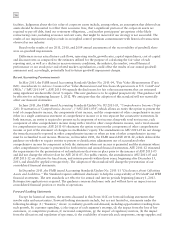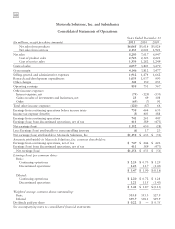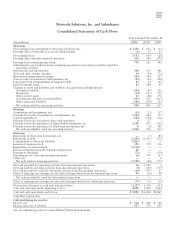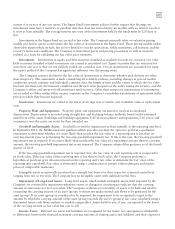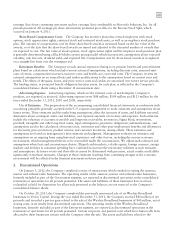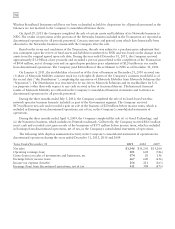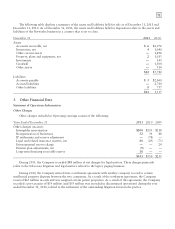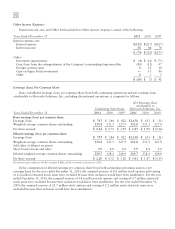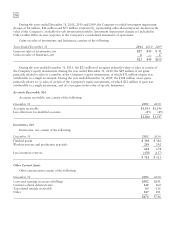Motorola 2011 Annual Report Download - page 72
Download and view the complete annual report
Please find page 72 of the 2011 Motorola annual report below. You can navigate through the pages in the report by either clicking on the pages listed below, or by using the keyword search tool below to find specific information within the annual report.
66
evidenced by the pricing rates of approximately 80% of such historical stand-alone transactions falling
within plus or minus 15% of the median rate. In addition, the Company considers the geographies in which
the products or services are sold, major product and service groups, customer classification, and other
environmental or marketing variables in determining VSOE.
• TPE—VSOE exists only when the Company sells the deliverable separately. When VSOE does not exist, the
Company attempts to determine TPE based on competitor prices for similar deliverables when sold
separately. Generally, the Company’s go-to-market strategy for many of its products differs from that of its
peers and its offerings contain a significant level of customization and differentiation such that the
comparable pricing of products with similar functionality sold by other companies cannot be obtained.
Furthermore, the Company is unable to reliably determine what similar competitor products’ selling prices
are on a stand-alone basis. Therefore, the Company is typically not able to determine TPE.
• ESP—The objective of ESP is to determine the price at which the Company would transact a sale if the
product or service were sold on a stand-alone basis. When both VSOE and TPE do not exist, the Company
determines ESP by first collecting all reasonably available data points including sales, cost and margin
analysis of the product, and other inputs based on the Company’s normal pricing practices. Second, the
Company makes any reasonably required adjustments to the data based on market and Company-specific
factors. Third, the Company stratifies the data points, when appropriate, based on customer, magnitude of
the transaction and sales volume.
Once elements of an arrangement are separated into more than one unit of accounting, revenue is recognized
for each separate unit of accounting based on the nature of the revenue as described above.
The Company’s arrangements with multiple deliverables may also contain a stand-alone software deliverable
that is subject to the existing software revenue recognition guidance. The revenue for these multiple-element
arrangements is allocated to the software deliverable and the non-software deliverable(s) based on the relative
selling prices of all of the deliverables in the arrangement using the hierarchy in the new revenue accounting
guidance. In circumstances where the Company cannot determine VSOE or TPE of the selling price for all of the
deliverables in the arrangement, including the software deliverable, ESP is used for the purpose of allocating the
arrangement consideration.
The Company accounts for multiple element arrangements that consist entirely of software or software-related
products, including the sale of software upgrades or software support agreements to previously sold software, in
accordance with software accounting guidance. For such arrangements, revenue is allocated to the deliverables
based on the relative fair value of each element, and fair value is determined by VSOE. Where VSOE does not exist
for the undelivered software element, revenue is deferred until either the undelivered element is delivered or VSOE is
established, whichever occurs first. When VSOE of a delivered element has not been established, but VSOE exists
for the undelivered elements, the Company uses the residual method to recognize revenue when the fair value of all
undelivered elements is determinable. Under the residual method, the fair value of the undelivered elements is
deferred and the remaining portion of the arrangement consideration is allocated to the delivered elements and is
recognized as revenue.
Changes in cost estimates and the fair values of certain deliverables could negatively impact the Company’s
operating results. In addition, unforeseen conditions could arise over the contract term that may have a significant
impact on operating results.
Cash Equivalents: The Company considers all highly-liquid investments purchased with an original maturity
of three months or less to be cash equivalents. At December 31, 2011, and 2010, restricted cash was $63 million
and $226 million, respectively.
Sigma Fund: The Company and its wholly-owned subsidiaries invest a significant portion of their U.S. dollar-
denominated cash in a fund (the “Sigma Fund”) that allows the Company to efficiently invest its cash around the
world. The Sigma Fund portfolio is managed by four independent investment management firms. The investment
guidelines of the Sigma Fund require that purchased investments must be in high-quality, investment grade (rated at
least A/A-1 by Standard & Poor’s or A2/P-1 by Moody’s Investors Service), U.S. dollar-denominated fixed income
obligations, including certificates of deposit, commercial paper, government bonds, corporate bonds and asset- and
mortgage-backed securities. Under the Sigma Fund’s investment policies, except for obligations of the U.S.
government, agencies and government-sponsored enterprises, no more than 5% of the Sigma Fund portfolio is to


